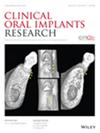即刻加载无瓣微型种植体用于全弓覆盖义齿修复:一项长达15年的回顾性研究。
IF 5.3
1区 医学
Q1 DENTISTRY, ORAL SURGERY & MEDICINE
引用次数: 0
摘要
目的本研究旨在通过短期、中期和长期随访评估无牙患者在上颌和下颌骨放置微型牙种植体(mdi)及其相关覆盖义齿的生存率。材料与方法采用微型种植体(直径≤2.9 mm)作为覆盖义齿支撑的患者,随访时间至少为3年。收集符合条件的患者的数据,并评估每个种植体的边际骨损失(MBL)。假体和种植体的主要结局包括失败率、并发症和种植体相关的MBL。结果在8.09±3.96年的平均随访期间,研究分析了83例患者和334个种植体。15年累积种植体存活率为86.3% (95% CI: 79.5%-91.0%)。平均MBL从植入时的0.09±0.44 mm增加到15年时的1.79±0.82 mm, Lodi Biomax种植体的年骨损失明显低于Dentatus Atlas种植体(p < 0.001)。假体存活率为95.45% (95% CI: 91.1-99.81)。较长的随访时间(p = 0.018)和较少的调整(p < 0.001)降低了并发症发生的风险。此外,Lodi Biomax种植体与Dentatus Atlas相比并发症较少(p = 0.039)。结论直径为2.4 ~ 3mm的微型种植体术后随访15年生存率较高。它们的使用为无牙患者提供了一种可行的假体解决方案,最大限度地减少了手术侵入性、康复时间和成本,特别是当固定假体不可行或患者不要求固定假体时。本文章由计算机程序翻译,如有差异,请以英文原文为准。
Flapless Mini Implants Immediately Loaded for Full-Arch Overdenture Rehabilitation: An Up-To-15-Year Retrospective Study.
OBJECTIVES
This study aimed to evaluate the survival rates of Mini Dental Implants (MDIs) placed in both the maxilla and the mandible, and their associated overdenture prostheses in edentulous patients over short-, medium-, and long-term follow-up periods.
MATERIALS AND METHODS
Patients rehabilitated with Mini Dental Implants (diameter ≤ 2.9 mm) as support for overdenture prostheses with a minimum follow-up period of 3 years were included in the study. Data from eligible patients were collected, and marginal bone loss (MBL) was assessed for each implant. The primary outcomes for the prostheses and implants included failure rates, complications, and implant-related MBL.
RESULTS
The study analyzed 83 patients and 334 implants over an 8.09 ± 3.96-year mean follow-up. The cumulative implant survival rate at 15 years was 86.3% (95% CI: 79.5%-91.0%). Mean MBL increased from 0.09 ± 0.44 mm at implant placement to 1.79 ± 0.82 mm at 15 years, with Lodi Biomax implants exhibiting significantly lower annual bone loss compared to Dentatus Atlas implants (p < 0.001). The prosthetic survival rate was 95.45% (95% CI: 91.1-99.81). Longer follow-up (p = 0.018) and fewer adjustments (p < 0.001) reduced risks of complication occurrence. Additionally, Lodi Biomax implants had fewer complications compared to Dentatus Atlas (p = 0.039).
CONCLUSION
Mini Dental Implants with a diameter between 2.4 and 3 mm showed high survival rates over follow-ups of up to 15 years. Their use offers a viable prosthetic solution for edentulous patients, minimizing surgical invasiveness, rehabilitation time, and costs, particularly when a fixed prosthesis is either not feasible or not requested by the patient.
求助全文
通过发布文献求助,成功后即可免费获取论文全文。
去求助
来源期刊

Clinical Oral Implants Research
医学-工程:生物医学
CiteScore
7.70
自引率
11.60%
发文量
149
审稿时长
3 months
期刊介绍:
Clinical Oral Implants Research conveys scientific progress in the field of implant dentistry and its related areas to clinicians, teachers and researchers concerned with the application of this information for the benefit of patients in need of oral implants. The journal addresses itself to clinicians, general practitioners, periodontists, oral and maxillofacial surgeons and prosthodontists, as well as to teachers, academicians and scholars involved in the education of professionals and in the scientific promotion of the field of implant dentistry.
 求助内容:
求助内容: 应助结果提醒方式:
应助结果提醒方式:


